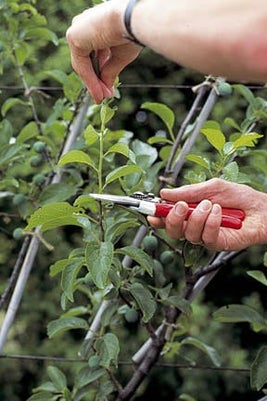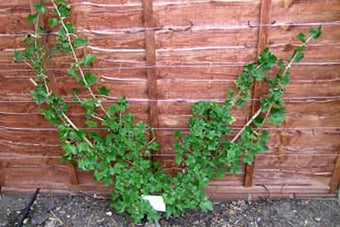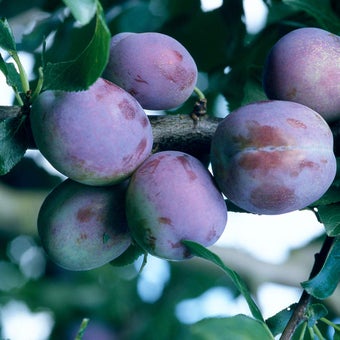
Quick facts
Suitable for - Almonds, apples, apricots, cherries, figs, gooseberries, nectarines, peaches, pears, plums and redcurrants
Timing - Summer
Difficulty - Moderate
Suitable for...
Fan-trained almonds, apples, cherries, figs, gooseberries, peaches, nectarines, apricots, pears, plums and redcurrants need to be pruned annually.
Fans are commonly used forstone fruits (eg. cherries and peaches), as they are not suited to being trained as espaliers or other restricted forms.
When to prune established fans
Prune fans in spring and summer on a dry day (when the risk of fungal infection is low). Removing leafy growth helps to restrict the vigour of trained fruit forms.
- Fig fans can be pruned in spring once the frosts have passed
- Redcurrant and gooseberry fans should be pruned in mid-summer and again in winter
- Apples and pear fans should be pruned in late summer when growth has slowed, to deter re-growth and encourage fruit
- Stone fruit pruning should be completed by late August to minimise the risk of fungal diseases, such as silver leaf
When it is necessary to remove a large limb within a fan, do this when apples pears, redcurrants and gooseberries are in winter or in April for stone fruit, reducing the risk of fungal diseases to which they are prone.
How to prune established fans
Peaches, nectarines and acid cherry
- These fruit almost entirely on shoots made in the previous season; so pruning aims to replace fruited wood with new, young wood
- After harvesting, cut older, fruited wood back to a vigorous new shoot and tie the young shoot into the framework in place of the older wood (replacement pruning). This new shoot should ripen and bear fruit next year
- Entirely remove badly-placed shoots (such as those growing into the wall)
- Reduce to two leaves any shoots that can’t be tied into the framework (due to lack of space or because they point directly away from the wall)
Apricots, sweet cherries and plums
- These bear fruit both on shoots made the previous season and on older wood; so pruning aims to create fruiting spurs and to occasionally replace some of the older wood with new, young wood
- In June, tie shoots into the framework where there is space
- Entirely remove congested or badly-placed shoots (such as those growing into the wall) as they appear
- Pinch back the remaining, new shoots to six leaves
- In August, after fruiting, shorten them further, cutting to three leaves to create a spur that will bear fruit next year
- Vigorous plums are prone to producing strong, upright shoots. If these cannot be tied down more horizontally into the framework, they should be cut out altogether
- Replacement pruning of one or two branches is recommended each year to ensure the framework includes young wood. Do this after fruiting in summer (following instructions for peaches, nectarines and acid cherries, point 2). With late plum cultivars harvested in autumn, replacement pruning can be left until spring
Apples and pears
- Apples and pears bear fruit on older wood, so pruning aims to build up a system of short spurs on an established framework. These spurs will bear fruit when they reach three years old
- Only prune new shoots that are longer than a pair of secateurs; leaving shorter ones unpruned
- Prune those that arise from the main framework to three leaves above the basal cluster of leaves. This will create a spur from which fruit will be borne in future years
- Prune those that arise from other laterals or spurs to one leaf above the basal cluster to keep the spur system compact
- Once fans are mature, old, congested spur systems may need out in winter
Gooseberries and redcurrants
- These bear fruit at the base of wood produced in previous seasons, so pruning aims to establish a spur system
- In early June, pinch back new shoots to five or six leaves
- In winter, cut these shoots back to two to form a short spur, which will carry fruit
- Once fans are mature, old, congested spur systems may need thinning out in winter
Figs
- Fruits mature from tiny, embryonic figs borne at the tips of stems produced in the previous year. Pruning aims to provide a plentiful supply of well-placed shoots and embryonic fruits by autumn.
- In spring prune back to 2.5cm (1in) half of the shoots that carried fruit to encourage growth of new replacement shoots. Remove shoots growing towards the wall.
- Tie in all remaining shoots, aiming for them to be evenly spaced 22.5-30cm (9in-1ft) apart. If the fig produced numerous new shoots and the growth is crowded, prune the surplus new shoots to one .
- As new shoots develop, tie them into the wires to fill gaps in the fan.
- In June, the growing tip of every other young shoot carried on the main framework to encourage lower, bushier growth. Do not pinch back all the shoots and do not trim shoot tips later in the growing season.
- If protecting the fan-trained fig against winterfrost damage by packing around the branches with at least 5cm (2in) layer of straw or bracken (secure in place with 15cm (6in) mesh), you can carry out the spring pruning in November prior to covering.
Recommended reading
For more detailed pruning instructions, read:
RHS Pruning and Training (Revised New Edition) by Christopher Brickell and David Joyce (Dorling Kindersley 2017, ISBN 9780241282908)
RHS Fruit by Harry Baker (Mitchell Beazley 1995, ISBN 9781857329056)
The Fruit Garden Displayed by Harry Baker (RHS 1991, ISBN 9780304340163)
These books are also available through the Lindley Library.
Stone fruit: overgrown and neglected fans
Neglected fans are often top heavy with little young wood below. To redress the balance renovation pruning needs to be staggered over several years.
In spring or early summer, shorten back a third of the uppermost shoots to a replacement shoot within the main framework. Also remove a few of the older shoots lower down, ideally to a young shoot further back that can be tied in to fill the gap. Any shoots growing vertically in the centre of the fan are best removed entirely, but avoid making cuts into the two main arms.

